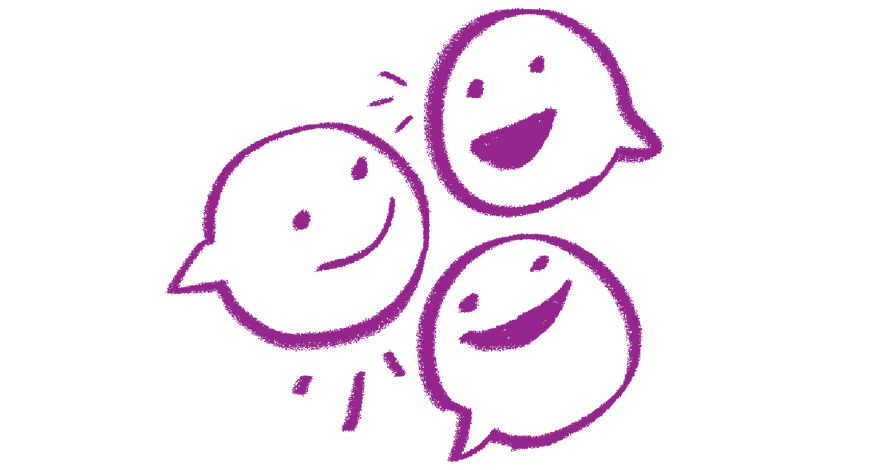
Editor’s note
January 19, 2021
Evaluating the impact of career programming on youth choices
January 19, 2021Recognizing the systemic barriers faced by transgender and nonbinary students, University of Toronto creates career guide in consultation with community
Allison Burgess and Sania Hameed
Illustrations by Beena Mistry

A proactive response
Many transgender and nonbinary students visit the Sexual and Gender Diversity Office (SGDO) at the University of Toronto, seeking support related to career development and job search strategies. Working with the Career Exploration and Education department, we recognized that while individuals could be supported one-on-one, there was clearly a need for customized career resources for trans and nonbinary students, given the additional systemic and interpersonal barriers faced when accessing work and careers.
According to the TransPulse project (Bauer & Scheim, 2015), “28% of trans Ontarians could not get employment references with their current name [and] 18% were turned down for a job” due to their gender identity and/or expression. The TransPulse report further states that despite 44% of respondents having a post-secondary or graduate degree, the median income was $15,000 a year for trans Ontarians. Our experience working with post-secondary students and the results from this study served as a call to action for our offices: How could we work toward addressing these disparities and be proactive in supporting trans and nonbinary communities?
Both of our departments have equity identified as a core value in our work: the SGDO is one of the University’s equity offices, and Career Exploration & Education makes an intentional commitment to equity in its departmental values and strategic plan. This intention supported the commitment, resourcing and collaborative effort that was needed to begin to address the above question. As a result, a new resource was developed in consultation with and at the request of trans and nonbinary students and alumni. Your Journey: A Career Guide for Trans and Nonbinary Students is a first-of-its-kind resource in Canada, offering strategies and insights that can support trans and nonbinary students to explore career options, apply for jobs and navigate the workplace (University of Toronto, 2020). The guide can also be used by career professionals in their work with students. Your Journey can be accessed by visiting the SGDO’s website and is free to download.
Trans or Transgender: An identity for a person with a gender other than the one assigned to them at birth, or whose gender identity and gender expression differs from the stereotypical masculine and feminine norms. It is also used as an umbrella term for those who identify as transgender, trans, gender non-conforming, genderqueer, nonbinary or an analogous term.
Nonbinary: A gender identity that does not fit within the male or female binary.

A collaborative effort
“Nothing about us without us” is a common rallying cry and call to action to ensure that work that aims to benefit a particular community is done with, alongside and in collaboration with that community, rather than without them or for them. This was one of the key principles we adhered to throughout this multi-year project – working with trans and nonbinary communities, as well as with the various career communities at the University of Toronto. Through an initial consultation process with trans and nonbinary students and faculty (including focus groups), we gained a better sense of the career learning needs of trans and nonbinary people. Additionally, recognizing that there are differences in campus contexts, we formed a tri-campus working group with representation from five additional career departments across faculties and the three campuses and within the University to envision and co-develop the first draft of the guide.
More from Careering and CareerWise
Case study: Job-shadowing program helps LGBTQ2+ students navigate workplace concerns
11 resources for supporting LGBTQ2+ clients’ career development
Making meaningful connections: LGBTQ2+ communications
Aware of our own positionality as cis authors working on a resource for trans and nonbinary communities, we organized additional focus groups of trans and nonbinary students, staff, faculty and alumni to provide detailed revisions, edits and responses to the drafted content. Career Exploration & Education and the SGDO took the lead in finalizing the draft, with additional input and review from the University of Toronto’s Accessibility for Ontarians with Disability (AODA) office, legal counsel and senior leadership. To move the guide into production, we hired Beena Mistry, a nonbinary illustrator, to provide the visuals for the guide. The welcoming tone and colours of the illustrations supported the design and layout of the guide, which was undertaken by SGDO student staff, providing another opportunity to involve students in the development process. Additionally, one of the most meaningful contributions to Your Journey were the quotes from trans and nonbinary alumni, who offered inspiration, advice and guidance to the reader. The production of the guide lasted two years, and was an iterative cycle of feedback and revision in order to best address the gap in service identified by trans and nonbinary students and recent alumni. We are proud to share Your Journey: A Career Guide for Trans and Nonbinary Students, and hope that it will be a useful resource for you, the students you work with and the career development work at your respective offices.

Illustration by Beena Mistry
Using an equity lens
Whether your department is thinking about trans-specific resources or other equity-focused career resources more broadly, there are many factors to consider to ensure all students are welcomed and supported. Use an equity lens to reflect on the resources and services that your department provides:
- Is equity or social justice identified as a value of your departmental mission? How is it materialized in day-to-day work?
- Is equity work done off the side of the desk, or have you committed time and resources (i.e. personnel and departmental funds) to do this work?
- Have you connected with a subject matter expert or thought leader to help you think through the equity-related gaps in your services?
- Example: Career Exploration & Education works in collaboration with equity offices (such as the SGDO), employers, student clubs and community partners to continue to address the needs of marginalized communities.
- Can people across a diversity of identities relate to your department? Do people across a diversity of identities access your department? Do people across a diversity of identities represent your department? If not, why not?
- Consider where the gaps are in your service provision. Have students identified specific needs or gaps? Do you have a mechanism to get feedback or input from a wide diversity of students?
- Example: In the early stage of this work, before the idea of a guide had materialized, Career Exploration & Education and SGDO worked with trans and nonbinary students to clarify their career learning needs. The idea to create a guide arose out of these consultations.
Conclusion
Elliot, one of the alumni quoted in the guide, explained that “as trans and gender nonconforming folks, we have additional worries about being accepted, supported and not tokenized in workplaces.” As higher-education professionals, understanding the complexity of the barriers that trans and nonbinary people face is essential as we work toward equitable employment outcomes for all of our students. While Your Journey won’t have all of the answers, we do hope that this guide serves as a useful resource for students and the staff who support them in navigating careers and the job search process.
Allison Burgess (she/her) is the Director of the Sexual & Gender Diversity Office at the University of Toronto. She earned her PhD in Sociology and Equity Studies in Education and the Graduate Collaborative Program in Women and Gender Studies from the Ontario Institute for Studies in Education (OISE/UT).
Sania Hameed (she/her) is a Career Educator at Career Exploration and Education at the University of Toronto. She earned her MEd in Higher Education from the Ontario Institute for Studies in Education (OISE/UT) and brings a strong equity lens to her work, particularly around issues of race and representation.
References
Bauer, G., and Scheim, A. (2015). Transgender People in Ontario, Canada. TransPulse: London, ON. Retrieved from https://transpulseproject.ca/wp-content/uploads/2015/06/Trans-PULSE-Statistics-Relevant-for-Human-Rights-Policy-June-2015.pdf
University of Toronto. (2020). Your Journey: A Career Guide for Trans and Nonbinary Students. Retrieved from https://www.hrandequity.utoronto.ca/wp-content/uploads/SGDO/Your%20Journey%20-%20A%20Career%20Guide%20for%20Trans%20and%20Nonbinary%20Students.pdf

